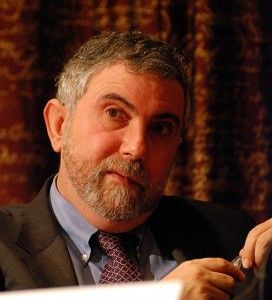 In recent days, New York Times economist Paul Krugman has been doing a whole bunch of interviews in which he has declared that the solution to our economic problems is very easy. Krugman says that all we need to do to get the global economy going again is for the governments of the world to start spending a lot more money. Krugman believes that austerity is only going to cause the economies of the industrialized world to slow down even further and therefore he says that it is the wrong approach. And you know what? Krugman is partly right about all of this. The false prosperity that the United States and Europe have been enjoying has been fueled by unprecedented amounts of debt, and in order to maintain that level of false prosperity we are going to need even larger amounts of debt. But there are several reasons why Krugman is mostly wrong. First of all, we have not seen any real “austerity” yet. Even though there have been some significant spending cuts and tax increases over in Europe, the truth is that nearly every European government is still piling up more debt at a frightening pace. Here in the United States, the federal government continues to spend more than a trillion dollars a year more than it brings in. If the United States were to go to a balanced federal budget, that would be austerity. What we have now is wild spending by the federal government beyond anything that John Maynard Keynes ever dreamed of. Secondly, Krugman focuses all of his attention on making things more comfortable for all of us in the short-term without even mentioning what we might be doing to future generations. Yes, more government debt would give us a short-term economic boost, but it would also make the long-term financial problems that we are passing on to our children even worse.
In recent days, New York Times economist Paul Krugman has been doing a whole bunch of interviews in which he has declared that the solution to our economic problems is very easy. Krugman says that all we need to do to get the global economy going again is for the governments of the world to start spending a lot more money. Krugman believes that austerity is only going to cause the economies of the industrialized world to slow down even further and therefore he says that it is the wrong approach. And you know what? Krugman is partly right about all of this. The false prosperity that the United States and Europe have been enjoying has been fueled by unprecedented amounts of debt, and in order to maintain that level of false prosperity we are going to need even larger amounts of debt. But there are several reasons why Krugman is mostly wrong. First of all, we have not seen any real “austerity” yet. Even though there have been some significant spending cuts and tax increases over in Europe, the truth is that nearly every European government is still piling up more debt at a frightening pace. Here in the United States, the federal government continues to spend more than a trillion dollars a year more than it brings in. If the United States were to go to a balanced federal budget, that would be austerity. What we have now is wild spending by the federal government beyond anything that John Maynard Keynes ever dreamed of. Secondly, Krugman focuses all of his attention on making things more comfortable for all of us in the short-term without even mentioning what we might be doing to future generations. Yes, more government debt would give us a short-term economic boost, but it would also make the long-term financial problems that we are passing on to our children even worse.
It is important to understand that Paul Krugman is a hardcore Keynesian. He believes that national governments can solve most economic problems simply by spending more money. His prescription for the U.S. economy in 2012 was summarized in a recent Rolling Stone article….
The basic issue, says Krugman, is a lack of demand. American consumers and businesses, aren’t spending enough, and efforts to get them to open their wallets have gone nowhere. Krugman’s solution: The federal government needs to step in and spend. A lot. On debt relief for struggling homeowners; on infrastructure projects; on aid to states and localities; on safety-net programs. Call it “stimulus” if you like. Call it Keynesian economics, after the great economic thinker (and Krugman idol) John Maynard Keynes, who first championed the idea that government has an essential role in saving the free market from its own excesses.
So is Krugman right?
Would the U.S. economy improve if the federal government borrowed and spent an extra half a trillion dollars this year for example?
Yes, it would.
But it would also get us half a trillion dollars closer to bankruptcy as a nation.
Krugman claims that “austerity” has failed, but the truth is that we have not even seen any real “austerity” yet.
When a government spends more than it brings in, that is not real austerity.
People talk about the “austerity” that we have seen in places such as Greece and Spain, but the truth is that both nations are still piling up huge amounts of new debt.
So let’s not pretend that the western world is serious about austerity.
The goal for most European nations at this point is to get their debts down to “sustainable” levels.
But for economists such as Krugman, this is a very bad idea. Krugman insists that cutting government spending during a recession is a very stupid thing to do. The following is from one of his recent articles in the New York Times….
For the past two years most policy makers in Europe and many politicians and pundits in America have been in thrall to a destructive economic doctrine. According to this doctrine, governments should respond to a severely depressed economy not the way the textbooks say they should — by spending more to offset falling private demand — but with fiscal austerity, slashing spending in an effort to balance their budgets.
Critics warned from the beginning that austerity in the face of depression would only make that depression worse. But the “austerians” insisted that the reverse would happen. Why? Confidence! “Confidence-inspiring policies will foster and not hamper economic recovery,” declared Jean-Claude Trichet, the former president of the European Central Bank — a claim echoed by Republicans in Congress here. Or as I put it way back when, the idea was that the confidence fairy would come in and reward policy makers for their fiscal virtue.
Yes, Krugman is correct that government austerity measures will only make a recession worse.
Just look at what has happened in Greece. Wave after wave of austerity measures has pushed Greece into an economic depression. If you want to see what austerity has done to the unemployment rate in Greece, just check out this chart.
As other nations across Europe have taken measures to get debt under control, we have seen similar economic results all across the continent.
The overall unemployment rate in the eurozone has hit 10.9 percent which is a new all-time high, and youth unemployment rates throughout Europe are absolutely skyrocketing.
Right now there are already 12 countries in Europe that are officially in a recession, and in many European nations manufacturing activity is slowing down dramatically.
So, yes, austerity is not helping short-term economic conditions in Europe.
But what are the nations of the western world supposed to do?
According to Krugman, they are supposed to run up gigantic amounts of new debt indefinitely.
And that is what the United States is doing right now. But at some point the clock strikes midnight and all of a sudden you have become the “next Greece”.
U.S. government debt is already rising much, much faster than U.S. GDP is.
Between 2007 and 2010, U.S. GDP grew by only 4.26 percent, but the U.S. national debt soared by 61 percent during that same time period.
Today, the U.S. national debt is equivalent to 101.5 percent of U.S. GDP.
But Paul Krugman does not consider this to be a major problem.
The Obama administration is currently stealing approximately 150 million dollars from our children and our grandchildren every single hour to finance our reckless spending, but for Paul Krugman that is not nearly good enough.
To Krugman, the only thing that is important is what is happening right now. Apparently the future can be thrown into the toilet as far as he is concerned.
The founder of PIMCO, Bill Gross, told CNBC on Tuesday that the U.S. government is likely to be hit with another credit rating downgrade this year if something is not done about our exploding debt.
The United States already has more government debt per capita than Greece, Portugal, Italy, Ireland or Spain does.
But Krugman insists that the solution to our economic problems is even more debt and even more spending.
In a previous article, I detailed how we are doomed if the U.S. government keeps spending money wildly like this and we are doomed if the U.S. governments stops spending money wildly like this.
If we keep running trillion dollar deficits every year, at some point our financial system will collapse, the U.S. dollar will fail, and we will essentially be facing national bankruptcy.
But if the federal government stops borrowing and spending money like this, our debt-fueled prosperity will rapidly disappear, unemployment will shoot well up into double digits, and we will soon have mass rioting in major U.S. cities.
The truth is that we have already been following Paul Krugman’s economic prescription for the nation for decades. Our 15 trillion dollar party has funded a standard of living unlike anything the world has ever seen, but the party is coming to an end.
The Federal Reserve is trying to keep the party going by buying up huge amounts of government debt. The Fed actually purchased approximately 61 percent of all government debt issued by the U.S. Treasury Department in 2011.
It is a shell game that cannot go on for too much longer.
The national debt crisis can be delayed for a while, but at some point the house of cards is going to come crashing down on top of us all.
If Paul Krugman wanted to talk about real solutions he could talk about shutting down the Federal Reserve and he could talk about going to an entirely debt-free currency.
But we all know that is not going to happen, don’t we?
As I have written about before, the Federal Reserve was designed to be a perpetual government debt machine. The system was designed to have the amount of money and the amount of government debt constantly expand.
And it has been working quite well in that regard. At this point, the U.S. national debt is more than 5000 times larger than it was when the Federal Reserve was first created.
But Paul Krugman is not going to talk about the real issues. Instead, he is just going to keep running around declaring that more government spending and more government debt will solve all of our problems.
It is a very big lie, but millions of people are going to believe it.





